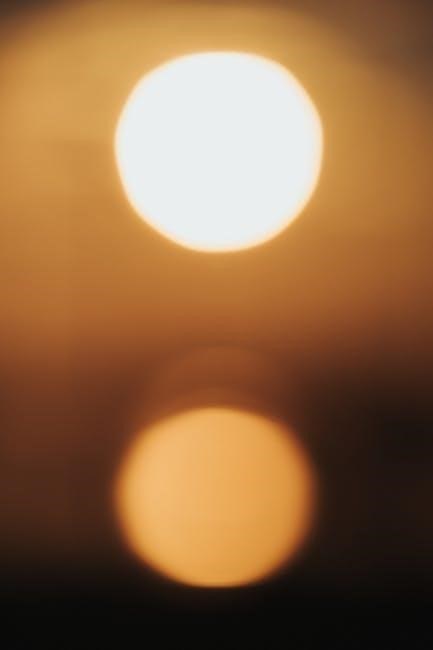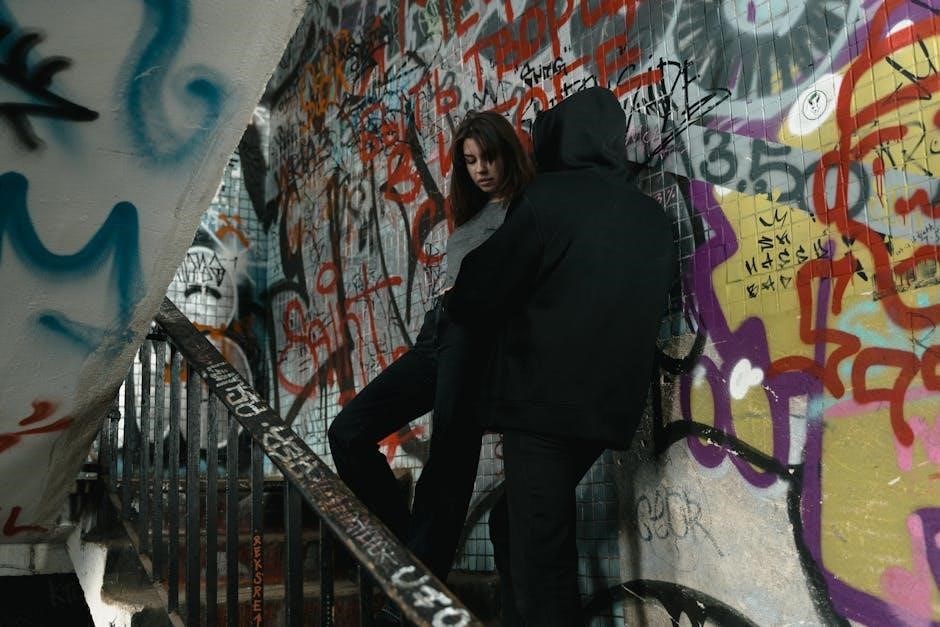Young’s Double Slit Experiment demonstrates light’s wave-particle duality, showing interference patterns when light passes through two slits. Conducted by Thomas Young in 1801, it remains a cornerstone in understanding wave properties and quantum mechanics, influencing modern physics education and research.
1.1 What is the Double Slit Experiment?
The Double Slit Experiment is a landmark demonstration of light’s wave-particle duality. It involves passing light through two parallel slits, creating an interference pattern on a screen. When light from a coherent source illuminates the slits, it diffracts and interferes, producing bright and dark fringes. This pattern confirms light’s wave-like behavior, as particles would not create such interference. The experiment, first performed by Thomas Young in 1801, is a foundational study in wave optics and quantum mechanics, showcasing how wave properties manifest in light’s behavior.
1.2 Historical Significance of the Experiment
Young’s Double Slit Experiment is historically significant as it provided conclusive evidence for the wave nature of light, challenging the prevailing particle theory supported by Newton. Conducted in 1801, it marked a turning point in understanding light’s behavior, influencing the development of wave optics and quantum mechanics. The experiment’s simplicity and profound implications made it a cornerstone of physics, reshaping scientific thought and inspiring further research into light’s dual nature. Its findings remain foundational in modern physics education and continue to be referenced in studies of wave-particle duality.
1.3 Purpose of the Experiment
The purpose of Young’s Double Slit Experiment was to determine whether light behaves as a wave or a particle. By observing the interference pattern created when light passes through two slits, Young aimed to challenge Newton’s corpuscular theory, which suggested light was composed of particles. The experiment tested the wave theory of light by demonstrating interference, a property unique to waves. Using sunlight and a card with two slits, Young observed bright and dark fringes, providing evidence for light’s wave-like behavior. This experiment laid the foundation for understanding wave-particle duality and remains a cornerstone in the study of light’s nature.
Historical Background of the Experiment
Conducted by Thomas Young in 1801, the Double Slit Experiment was a pivotal moment in physics, demonstrating light’s wave-like nature and challenging particle theories of light.
2.1 Thomas Young and His Contributions to Physics
Thomas Young (1773–1829) was a British polymath whose work spanned physics, physiology, and Egyptology. His Double Slit Experiment in 1801 provided critical evidence for the wave nature of light. Young also made significant contributions to the study of vision and color theory. His work laid the foundation for modern wave optics and quantum mechanics, influencing generations of scientists. Additionally, Young’s research in acoustics and solid mechanics further showcased his versatility as a scientist.
2.2 The First Double Slit Experiment in 1801
In 1801, Thomas Young conducted his groundbreaking Double Slit Experiment to investigate the nature of light. He directed a beam of sunlight through two parallel slits cut into a card, projecting the result onto a screen. Contrary to expectations for particles, an interference pattern emerged, with alternating bright and dark fringes. This demonstrated light’s wave-like behavior, challenging Newton’s particle theory. Young’s innovative setup and observations provided direct evidence for wave interference, marking a pivotal moment in the history of physics and laying the foundation for modern quantum mechanics.
2.3 Initial Reactions to the Experiment
When Young presented his Double Slit Experiment in 1801, it faced significant skepticism. The scientific community, heavily influenced by Newton’s particle theory of light, struggled to accept wave-particle duality. Many dismissed Young’s findings as anomalies or experimental errors. The interference pattern observed was seen as counterintuitive, challenging established beliefs. Despite initial resistance, Young’s work gradually gained recognition, particularly after Fresnel’s mathematical validation of wave theory. Over time, the experiment became a cornerstone of physics, reshaping understanding of light and paving the way for quantum mechanics. Its revolutionary implications were eventually embraced, though not without prolonged debate.

Apparatus and Setup of the Experiment
The apparatus includes a coherent light source, a double-slit barrier, and a screen to observe interference patterns. The setup ensures light passes through two parallel slits, creating wave interference.
3.1 Components of the Double Slit Apparatus
The double slit apparatus consists of a coherent light source, two parallel slits, and a screen to display the interference pattern. The light source emits monochromatic waves, ensuring uniformity. The slits are precisely spaced to allow wave interference; A screen or detector captures the resulting pattern, showing bright and dark fringes. Modern setups may include lasers for better coherence and digital sensors for precise measurements. Essential for demonstrating wave properties, this apparatus remains fundamental in physics education and research.
3.2 Coherent Light Sources
A coherent light source is essential for observing interference patterns in Young’s Double Slit Experiment. Coherent light consists of waves with the same wavelength, frequency, and a steady phase relationship. Traditionally, sunlight was used, but modern setups often employ lasers for their high coherence. The light source must emit monochromatic or near-monochromatic light to produce distinct fringes. Coherence ensures that waves from the two slits interact predictably, creating constructive and destructive interference. Without a coherent source, the interference pattern becomes unclear or disappears entirely, making it crucial for the experiment’s success.
3.3 The Role of the Screen in Observing the Pattern
The screen serves as the medium to visualize the interference pattern in Young’s Double Slit Experiment. Positioned at a distance from the slits, it captures the alternating bright and dark fringes formed by wave interference. The screen’s surface must be uniform and flat to accurately display the pattern. In modern setups, digital screens or photographic paper are sometimes used for precise measurements. The distance between the slits and the screen affects the fringe spacing, with farther distances resulting in wider patterns. This makes the screen a critical component for observing and analyzing the experiment’s outcome effectively.

Procedure of the Experiment
Align the light source with the slits, ensure proper positioning, and adjust for coherent interference. Observe the pattern on the screen and measure fringe spacing accurately.
4.1 Step-by-Step Setup of the Experiment
The setup begins with assembling the double-slit apparatus, ensuring the slits are parallel and evenly spaced. Next, position the light source to align with the slits, using a monochromatic source for coherence. Mount the apparatus on an optical bench for stability. Place a screen at a suitable distance behind the slits to capture the interference pattern. Adjust the light intensity and alignment to optimize visibility. Finally, secure all components and ensure the environment is free from vibrations to maintain consistent results during the experiment.
4.2 Aligning the Light Source and Slits
Aligning the light source and slits is critical for obtaining a clear interference pattern. Begin by positioning the light source directly in front of the double-slit apparatus. Adjust the source to ensure the light beam is centered on both slits. Use a laser pointer or crosshairs to achieve precise alignment. Next, verify that the slits are parallel and evenly spaced. Fine-tune the apparatus to ensure the light passes uniformly through both slits. Finally, secure the setup to prevent movement, ensuring stable conditions for observing the interference pattern. Proper alignment guarantees optimal experimental results.
4.3 Observing the Interference Pattern
Once aligned, shine the light through the slits and observe the pattern on the screen. A series of bright and dark fringes will appear, indicating constructive and destructive interference. The central fringe is the brightest, with alternating dimmer fringes on either side. Measure the spacing between fringes to calculate the wavelength of light. Ensure the light source is stable and the setup is undisturbed for clear observations. The interference pattern confirms the wave-like behavior of light, with fringe spacing influenced by slit separation and light wavelength. Accurate observation is essential for interpreting the experiment’s results effectively.

Observations and Results
The experiment produces an interference pattern of bright and dark fringes on the screen, confirming light’s wave nature through constructive and destructive interference.
5.1 The Interference Pattern on the Screen
The interference pattern observed on the screen consists of alternating bright and dark fringes, formed due to constructive and destructive interference of light waves. The central fringe is the brightest, with intensity decreasing symmetrically on either side. This pattern arises because light waves passing through the two slits interfere, creating regions of reinforcement and cancellation. The spacing between fringes depends on the wavelength of light, slit separation, and screen distance. This visible demonstration of wave interference is a direct confirmation of the wave-like behavior of light in Young’s experiment.
5.2 Bright and Dark Fringes
Bright fringes occur due to constructive interference, where wave peaks align, reinforcing light intensity. Dark fringes result from destructive interference, where wave peaks cancel each other. The central fringe is the brightest, with diminishing intensity toward the edges. The spacing between fringes depends on the wavelength of light, slit separation, and screen distance. These patterns are measurable, allowing calculations of light properties. Bright and dark fringes visually confirm wave interference, a fundamental aspect of Young’s experiment, demonstrating light’s wave-like behavior through observable intensity variations on the screen.
5.3 Measuring the Distance Between Fringes
To measure the distance between fringes, observers record the spacing between consecutive bright or dark fringes on the screen. Using a ruler or calibrated scale, the separation is typically measured from the centers of adjacent fringes. The central bright fringe serves as a reference point. By calculating the average distance over multiple fringe pairs, experimental accuracy improves. This measurement is crucial for determining properties like the wavelength of light or slit separation, using formulas derived from interference principles. Precise measurements validate theoretical predictions and demonstrate the wave-like behavior of light in Young’s experiment.

Explanation of the Results
The interference patterns observed in Young’s Double Slit Experiment confirm light’s wave-like behavior, with bright fringes indicating constructive interference and dark fringes showing destructive interference.
6.1 Wave-Particle Duality of Light
Young’s Double Slit Experiment revealed light’s wave-particle duality, as interference patterns indicated wave-like behavior, while photon experiments later confirmed particle-like properties. This duality is central to quantum mechanics, showing light can behave as both waves and particles depending on observation. The experiment’s results align with the principle that particles like electrons also exhibit wave-like interference when unobserved, fundamentally challenging classical interpretations of matter and energy. This groundbreaking insight transformed our understanding of light and its nature, bridging the gap between classical physics and modern quantum theory.
6.2 Huygens’ Principle and Wave Interference
Huygens’ Principle explains that every point on a wavefront acts as a source of secondary wavelets. In Young’s Double Slit Experiment, light passing through the slits creates wavefronts that interfere. These wavelets from the slits propagate and overlap, resulting in constructive (bright fringes) or destructive (dark fringes) interference. The principle validates the wave-like behavior of light, as the interference pattern arises from the superposition of these secondary waves. This fundamental concept aligns with the experiment’s observations, demonstrating how wave properties of light manifest through interference, a cornerstone of wave theory and quantum mechanics.
6.3 Constructive and Destructive Interference
Constructive interference occurs when wave crests align, reinforcing each other, producing bright fringes. Destructive interference happens when crests and troughs align, canceling out, resulting in dark fringes. In Young’s Double Slit Experiment, light waves from the two slits interfere based on their path difference. When the path difference is an integer multiple of the wavelength, constructive interference creates bright bands. Conversely, when the path difference is a half-integer multiple, destructive interference produces dark bands. This alternating pattern of bright and dark fringes confirms the wave-like behavior of light and forms the basis of interference phenomena in wave theory.

Quantum Mechanics and the Double Slit Experiment
The double-slit experiment reveals light’s wave-particle duality, a cornerstone of quantum mechanics. It demonstrates how particles like electrons and photons exhibit wave-like interference patterns, challenging classical theories and shaping quantum understanding.
7.1 Wave Function and Probability in Quantum Mechanics
In quantum mechanics, the double-slit experiment illustrates the wave function’s role in describing probabilities. When unobserved, particles like electrons or photons exhibit wave-like interference, as their wave functions overlap. This creates a probability distribution, visualized as bright and dark fringes. The wave function’s square represents the likelihood of finding a particle at a specific location. The experiment highlights superposition, where particles exist in multiple states simultaneously. Observation collapses the wave function, demonstrating the probabilistic nature of quantum phenomena. This duality between wave and particle is central to quantum theory, explaining how matter behaves probabilistically at microscopic scales.
7.2 The Experiment with Particles (Electrons, Photons)
The double-slit experiment with particles like electrons and photons reveals their wave-like behavior. When electrons pass through the slits, they create an interference pattern on the screen, similar to light. Even when sent individually, they build up the pattern over time, showing wave properties. Photons also exhibit this duality, interfering with themselves. However, when observed at the slits, particles behave like discrete entities, collapsing the wave function. This demonstrates the wave-particle duality and the influence of measurement on quantum systems. The experiment underscores the probabilistic nature of particle behavior, aligning with quantum mechanics’ principles.
7.3 Implications of the Experiment on Quantum Theory
The double-slit experiment significantly influenced quantum theory by demonstrating wave-particle duality and the probabilistic nature of particles. It showed that particles like electrons and photons exhibit wave-like interference when unobserved, while measurement forces them to behave as particles. This supported the quantum mechanical principle of superposition, where particles exist in multiple states until measured. The experiment also highlighted the role of observation in collapsing the wave function, a fundamental concept in quantum mechanics. These findings have shaped our understanding of quantum phenomena and remain central to modern quantum theory and research.

Variations of the Double Slit Experiment
Modern variations include using different light sources, materials, and even particles like electrons and photons, advancing our understanding of wave-particle duality and quantum mechanics principles.
8.1 Double Slit Experiment with Different Light Sources
The double slit experiment has been conducted with various light sources, including monochromatic and polychromatic light. Traditionally, sunlight was used, but modern setups often employ lasers or LEDs for greater coherence and visibility. Coherent light sources are essential to produce clear interference patterns, as they ensure consistent phase differences. Different wavelengths of light can also be tested, allowing for the study of how interference patterns vary with wavelength. This variation helps in understanding the wave properties of light and its behavior under different conditions, making the experiment versatile for educational and research purposes.
8.2 Double Slit Experiment with Various Slit Materials
Experiments have explored the use of different materials for the slits, such as metal, opaque, or even nanostructured surfaces. The material properties can influence diffraction patterns and interference effects. Metal slits, for instance, introduce additional diffraction effects due to their conductive nature. Opaque materials with precisely cut slits maintain the coherence of light, ensuring clear interference patterns. Variations in slit materials allow researchers to study how light interacts with different surfaces, providing insights into wave behavior and material properties. This adaptability enhances the experiment’s educational and research value, demonstrating its versatility in understanding light’s wave nature.
8.3 Modern Variations of the Experiment
Modern variations of Young’s Double Slit Experiment incorporate advanced technologies to enhance precision and accessibility. Automated setups with lasers and digital detectors allow real-time data collection and analysis. Computational simulations recreate interference patterns, aiding educational purposes. Researchers also explore quantum variations, such as using electrons or photons, to study wave-particle duality. These innovations expand the experiment’s scope, enabling deeper insights into quantum mechanics and wave behavior. Modern adaptations ensure the experiment remains a vital tool for both research and education, bridging classical and quantum physics concepts.

Educational Significance of the Experiment
Young’s Double Slit Experiment is a cornerstone in physics education, demonstrating wave properties of light and wave-particle duality; It simplifies complex concepts, making them accessible to students while highlighting historical contributions to modern physics.
9.1 Teaching Wave Properties of Light
Young’s Double Slit Experiment is an invaluable tool for teaching the wave properties of light. It vividly demonstrates interference patterns, which are a direct result of light’s wave-like behavior. By observing bright and dark fringes on a screen, students can visualize concepts such as constructive and destructive interference. This hands-on approach helps in understanding wave superposition and diffraction, making abstract ideas more tangible. The experiment also introduces the principle of wave-particle duality, sparking curiosity about the nature of light. Its simplicity and clarity make it an essential demonstration in physics education, bridging theory with practical observation.
9.2 Hands-On Learning in Physics
Young’s Double Slit Experiment offers a practical, hands-on approach to learning fundamental physics concepts. By setting up the apparatus and observing interference patterns, students engage directly with wave phenomena like diffraction and interference. This interactive method enhances understanding of abstract principles, such as constructive and destructive interference, by allowing students to measure and analyze the fringe patterns. The experiment fosters critical thinking and scientific inquiry, encouraging students to explore the wave-particle duality of light. Its simplicity and visual results make it an effective tool for reinforcing theoretical knowledge through experimental observation and data analysis.
9.3 Integration into Physics Curricula
Young’s Double Slit Experiment is a cornerstone of physics education, seamlessly integrating into curricula to teach wave properties, interference, and quantum principles. It bridges classical and modern physics, providing a practical demonstration of wave-particle duality. The experiment is often included in undergraduate and advanced high school courses to illustrate key concepts like diffraction, interference, and the probabilistic nature of light. Its simplicity and visual results make it an ideal tool for fostering deeper understanding of wave mechanics and quantum theory. By incorporating this experiment into lab sessions, educators enable students to connect theoretical knowledge with experimental observations, enhancing their grasp of fundamental physics principles.

Modern Applications of the Double Slit Experiment
The Double Slit Experiment inspires technologies in physics, contributes to quantum mechanics research, and is used in interferometry and optics, advancing our understanding of wave-particle behavior.
10.1 Inspiring Technologies in Physics
The Double Slit Experiment has inspired significant advancements in quantum technologies, particularly in understanding wave-particle duality. Its principles are foundational in quantum computing, where interference phenomena are harnessed to process information. Additionally, the experiment’s insights into wave behavior have driven innovations in photonics, enabling precise light manipulation in fiber optics and lasers. Techniques like holography and interferometry, essential in telecommunications and materials science, trace their conceptual roots to this experiment. By demonstrating light’s dual nature, Young’s work continues to influence modern physics research, paving the way for breakthroughs in nanotechnology and quantum mechanics.
10.2 Contributions to Quantum Mechanics Research
Young’s Double Slit Experiment fundamentally shaped quantum mechanics by demonstrating wave-particle duality. The interference patterns observed with light, and later with particles like electrons and photons, challenged classical notions of determinism. This experiment inspired quantum theories, such as wave functions and probabilistic outcomes. It also influenced interpretations like the Copenhagen model and pilot-wave theory. The experiment’s results are central to understanding quantum superposition and the role of observation in collapsing wave functions. Its implications continue to drive research in quantum mechanics, offering insights into the nature of reality at the microscopic level and the behavior of matter and energy.
10.3 Use in Interferometry and Optics
Young’s Double Slit Experiment laid the foundation for interferometry, a technique exploiting light’s wave nature to measure precise distances or surface properties. Optical interferometers, used in telecommunications and astronomy, rely on interference patterns to analyze light wave behavior. The experiment’s principles are applied in fiber optic sensors and gravitational wave detectors, demonstrating its practical utility in modern optics. Its insights into wave interference are crucial for understanding phenomena like phase shifts and coherence, making it indispensable in advanced optical research and engineering applications.

Common Questions and Misconceptions
Common questions include why the interference pattern disappears with single slits and whether visible light can be used. Misconceptions often arise about wave-particle duality and light’s behavior, but the experiment clearly demonstrates wave properties and their practical applications in modern optics and quantum mechanics, as explained in the provided PDF.
11.1 Why Does the Interference Pattern Disappear with Single Slits?
The interference pattern disappears with single slits because interference requires two coherent sources. A single slit does not provide a second source for wave interference, resulting in only diffraction. Without two slits, light behaves differently, and the alternating bright and dark fringes vanish. This highlights the necessity of dual coherent sources for observing interference phenomena, as explained in the PDF. Single-slit setups demonstrate diffraction but not interference, emphasizing the role of multiple slits in creating the characteristic pattern. This fundamental aspect is crucial for understanding wave behavior in the double-slit experiment.
11.2 Why Are Coherent Sources Essential for the Experiment?
Coherent sources are crucial for the double-slit experiment as they ensure synchronized waveforms from both slits. This synchronization allows constructive and destructive interference, producing a clear pattern. Without coherence, the waves would not consistently interfere, resulting in a blurred or absent pattern. Coherent light sources, such as lasers, provide the necessary stability and uniformity in wavelength and phase, enabling precise interference. The PDF emphasizes that coherence is vital for observing the characteristic bright and dark fringes, making it a fundamental requirement of the experiment. This underpins the wave nature of light demonstrated by Young’s setup.
11.3 Can the Experiment Be Conducted with Visible Light?
Yes, the double-slit experiment can be conducted with visible light, as Thomas Young originally used sunlight in his 1801 experiment. However, using visible light requires careful setup to ensure monochromatic conditions, as sunlight contains multiple wavelengths. Modern experiments often use lasers for greater precision, but visible light sources like monochromatic LEDs or filtered sunlight can also produce clear interference patterns. The key is maintaining coherence and consistency in the light waves to observe the characteristic bright and dark fringes. Visible light experiments remain a practical way to demonstrate wave interference principles in educational settings.
Young’s Double Slit Experiment is a landmark study that demonstrated the wave nature of light and laid the foundation for quantum mechanics. Its interference patterns, produced by light passing through two slits, revealed wave properties such as constructive and destructive interference. The experiment’s simplicity and profound implications have made it a cornerstone of physics education. It not only confirmed the wave-particle duality of light but also inspired modern variations with particles like electrons and photons. This experiment’s legacy continues to influence research and teaching, offering insights into the fundamental nature of light and matter in the quantum world.
